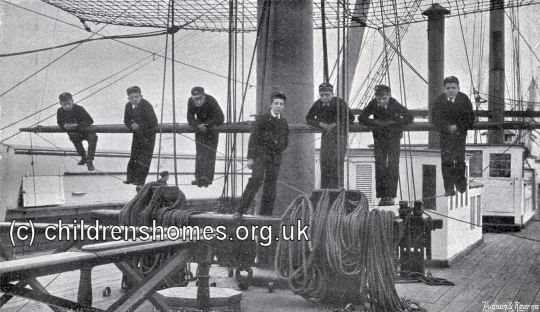Training Ship Conway, Birkenhead, Cheshire
In April, 1858, the Mercantile Marine Service Association set up a committee to establish a training ship on the Mersey 'to train and educate young gentlemen with a view to their becoming masters and officers in the Merchant Service.' For the purpose, the Admiralty offered the Conway, a frigate which had previously been used by for coastguard duties at Devonport. The Conway was moored on the Mersey, off Rock Ferry, near Birkenhead, and was opened on August 1st, 1859.
Two years later, the original Conway was replaced by HMS Winchester (renamed Conway). However, she ultimately proved too small for the purpose and in 1876 was redeployed as an Industrial School Ship under the name Mount Edgcumbe, anchored off Saltash in Cornwall. Her replacement was the former HMS Nile, a vessel noted for having been designed by the eminent naval architect, Sir Robert Seppings.

Training Ship Conway, 1898. © Peter Higginbotham

Training Ship Conway, boys on upper deck, 1898. © Peter Higginbotham

Training Ship Conway, boys on monkey yard, 1898. © Peter Higginbotham
Boys accepted for admission to the ship were between 13 and 16 years of age. An annual payment (£52. 10s. in 1890) a year was required which covered uniform and outer clothing, medical attendance, washing, use of books, and school stationery. Underclothing and boots were to be provided by parents or friends. The sons of nautical members of the Mercantile Service Association, and of deceased and unfortunate members of the Merchant Service, were given privileges in admission, and those of officers in the Royal Navy were admitted at a discounted rate (£42 a year in 1890). Free nominations to the ship were also occasionally granted. Applications for admission had to produce a birth certificate and a testimonial of good character from their last schoolmaster (or, if educated at home, from the clergyman or minister of church they attended). Boys who were colour-blind were warned that they could not become officers in the Merchant Service.

Training Ship Conway, sextant work, 1898. © Peter Higginbotham

Training Ship Conway, group of cadets, 1898. © Peter Higginbotham
A gold medal was presented each year by Queen Victoria 'to encourage the boys to acquire and maintain the qualities which will make the finest sailor.' The Queen also, to encourage Conway boys to qualify themselves for the cadetships in the Navy granted by the Admiralty, gave an annual prize of an inscribed binocular glass, and £35 towards the cost of their outfit to boys who competed for cadetships in Her Majesty's Service. The ship also benefitted from ten appointments as midshipmen in the Royal Naval Reserve granted each year by the Lords of the Admiralty.

Training Ship Conway, Captain Miller and Jubilee Review, 1898. © Peter Higginbotham
The 1876 Conway stayed at Rock Ferry until 1941 when, to avoid enemy bombing, she was moved to the Menai Straits. Her end came in 1953 when she was being towed to Birkenhead for a refit. She went aground near the Menai Suspension Bridge, broke her back and caught fire. The wreck remained there until catching fire fire while the Caernarfon Harbour Board was in the process of removing it. The vessel's remains are said to still be visible at very low tide.

Training Ship Conway wrecked on Menai Straits, 1953. © Peter Higginbotham
The ship was replaced by the shore-based HMS Conway Cadet Training School, at Plas Newydd, Anglesey. Following a decline in numbers being admitted to the establishment, it was closed in 1974.
Eminent Conway cadets included Captain Matthew Webb, the first man to swim the English Channel in 1875; Sir Arthur Rostron, captain of the Carpathia, which rescued the survivors of the Titanic; and John Masefield, the Poet Laureate from 1930 to 1967, who in 1902 published Sea Fever: 'I must down to the seas again, to the lonely sea and the sky...'
Records
Note: many repositories impose a closure period of up to 100 years for records identifying individuals. Before travelling a long distance, always check that the records you want to consult will be available.
- Maritime Archives and Library, Merseyside Maritime Museum, Albert Dock, Liverpool Waterfront, Liverpool L3 4AQ. Holdings include: Annual Reports (1859-1894); Monthly Reports (1881-1908); Muster Rolls (1875-1959); Wages Books (1882-1960: Visitor Books (1934-1975); Indexes to Registers and Registers of Cadets (1859-1972); Bound and loose volumes of the Cadet Magazine (1889-1974); Photographs of cadets, sporting events etc. (1891-1968).
Bibliography
- Windsor, Alfred HMS Conway: 1859-1974 (Witherby Seamanship International Ltd, 2008)
- Carridice, Phil Nautical Training Ships: An Illustrated History (2009, Amberley Press)
- Higginbotham, Peter Children's Homes: A History of Institutional Care for Britain's Young (2017, Pen & Sword)
Links
- HMS Conway 1859-1974
- The Conway Club for former cadets.
Except where indicated, this page () © Peter Higginbotham. Contents may not be reproduced without permission.


